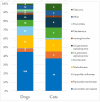Antimicrobial Resistance in Companion Animals: A 30-Month Analysis on Clinical Isolates from Urinary Tract Infections in a Veterinary Hospital
- PMID: 40509013
- PMCID: PMC12153634
- DOI: 10.3390/ani15111547
Antimicrobial Resistance in Companion Animals: A 30-Month Analysis on Clinical Isolates from Urinary Tract Infections in a Veterinary Hospital
Abstract
Bacterial urinary tract infections (UTIs) are common in small animal practice and their inappropriate treatment contributes to the antimicrobial resistance (AMR) spreading. This study assessed bacterial prevalence, non-susceptibility percentages, antimicrobial prescription and the impact of the application of international guidelines redacted by the International Society for Companion Animals Infectious Disease (ISCAID) in dogs and cats with UTIs evaluated at a European veterinary university hospital, over a 30-month period. A total of 729 bacterial isolates were included. The most frequently isolated bacterial species was Escherichia coli in both dogs (52.8%) and cats (45.7%). Following ISCAID guidelines, almost half of the cases were classified as upper UTIs (24.9%) or recurrent cystitis (24.8%). Multidrug resistance (MDR) percentage was 37.3% (n = 272). Over five semesters, MDR significantly decreased (p = 0.001). Additionally, a significant decrease was recorded for specimens from patients previously treated (p = 0.018) and under treatment at sampling (p < 0.001). Previous treatment with amoxicillin-clavulanate (p = 0.001), marbofloxacin (p < 0.001), enrofloxacin (p < 0.001) and piperacillin-tazobactam (p = 0.016) was linked with higher MDR rates. This study highlighted that companion animals are potential reservoirs for AMR; moreover, international guidelines applied in the daily practice guiding antimicrobial stewardship can lead to a reduction in AMR over time.
Keywords: ISCAID guidelines; companion animals; cystitis; multidrug antibiotic resistance; small animal infection; subclinical bacteriuria; surveillance.
Conflict of interest statement
The authors declare no conflicts of interest.
Figures



Similar articles
-
Monitoring the Prevalence of Antimicrobial Resistance in Companion Animals: Results from Clinical Isolates in an Italian University Veterinary Hospital.Transbound Emerg Dis. 2023 Sep 14;2023:6695493. doi: 10.1155/2023/6695493. eCollection 2023. Transbound Emerg Dis. 2023. PMID: 40303797 Free PMC article.
-
Antimicrobial resistance in clinical Escherichia coli isolated from companion animals in Australia.Vet Microbiol. 2017 Nov;211:43-50. doi: 10.1016/j.vetmic.2017.09.014. Epub 2017 Sep 21. Vet Microbiol. 2017. PMID: 29102120
-
International Society for Companion Animal Infectious Diseases (ISCAID) guidelines for the diagnosis and management of bacterial urinary tract infections in dogs and cats.Vet J. 2019 May;247:8-25. doi: 10.1016/j.tvjl.2019.02.008. Epub 2019 Feb 26. Vet J. 2019. PMID: 30971357
-
Urinary tract infection and subclinical bacteriuria in cats: A clinical update.J Feline Med Surg. 2019 Nov;21(11):1023-1038. doi: 10.1177/1098612X19880435. Epub 2019 Oct 10. J Feline Med Surg. 2019. PMID: 31601143 Free PMC article. Review.
-
An update on the management of urinary tract infections in the era of antimicrobial resistance.Postgrad Med. 2017 Mar;129(2):242-258. doi: 10.1080/00325481.2017.1246055. Epub 2016 Oct 21. Postgrad Med. 2017. PMID: 27712137 Review.
References
-
- WHO . WHO List of Critically Important Antimicrobials for Human Medicine (WHO CIA List) World Health Organization; Geneve, Switzerland: 2019.
LinkOut - more resources
Full Text Sources
Miscellaneous

